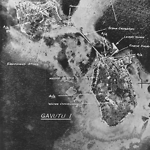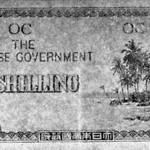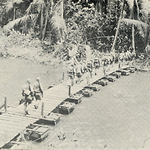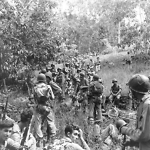Event: Second World War (Solomon Islands)
- Functions
- Labour
- Alternative Names
- Labour during the Second World War
- World War II
Details
The Second World War in the Solomon Islands has generated a huge literature. There are hundreds of books, articles, chapters and diaries written on the Pacific war generally, and many works by Solomon Islands specialist academics such as David Gegeo, David Akin, Hugh Laracy, James Boutilier, Judith Bennett and Geoffrey White. The Solomons was a crucial turning point for the Pacific war. On Guadalcanal the Allied forces, spearheaded by the Americans, met and turned back the Japanese advance. The fighting was bloody and protracted and involved great numbers of foreigners and unimaginable amounts of equipment. Solomon Islanders participated both formally and informally as a war not of their making raged around them. The eventual outcome was that the Solomon Islands would never again be a sleepy colonial backwater.
War in Europe in 1939 had few consequences for the Solomon Islands, except initially when copra and rubber prices rose, but this was short-lived since transport difficulties soon reduced the availability of shipping. The Protectorate began planning for the possibility that war might reach the islands, plans that intensified after the fall of Singapore and the attack on Pearl Harbour on 7 December 1941, and the capture of Rabaul, New Guinea on 23 January 1942. Clearly, the Solomon Islands were in the path of the Japanese southward advance.
Europeans began to be evacuated from Tulagi and other administrative centres, and plantations and mission stations in late December 1941, first women and children followed by government and commercial companies' staff and equipment. On 22 January Japanese aircraft bombed Gavutu next to Tulagi, and Fala, a member of the Solomon Islands Defence Force, took the first retaliatory shot at a Japanese patrol plane. The last European civilians departed Tulagi on SS Morinda on 8 February. The Japanese landed at Fauabu on Malaita where they remained until November, and visited and looted Auki. There were also some bombing raids in Langalanga Lagoon and islands at the eastern end of Maramasike Passage in 1943, probably by the Allies. Makira, Ulawa and the Eastern Solomons remained unoccupied by the Japanese. On 11 February, Resident Commissioner William Marchant (q.v.) moved his headquarters to Auki, Malaita and then to Fulisango in the hills behind. He took with him or sent to Sydney crucial government documents, particularly the land files. Marchant's group at Fulisango included Malaita District Officer C.N.F. Bengough, T. W. Sexton (the Government Wireless Officer), H. W. Bullen of the Melanesian Mission, who acted as a Cypher Officer, and the Anglican Bishop, followed later by the Catholic Bishop. (Trench 1956; Baddeley 1942)
The only European residents who remained in the Protectorate were the Resident Commissioner and five of his officers who functioned as coastwatchers (q.v.), the Catholic Bishop, priests and sisters, the Anglican Bishop and fifteen of his staff, Norman Deck and five of his SSEM staff, and a few planters scattered through the southern islands. The British attitude toward the Chinese was made fairly clear when foreign nationals were sent to Australia but the Chinese were left behind. Some Chinese joined the coastwatchers, others managed to find a ship heading for Sydney or Noumea, and the rest hid in villages for the war's duration, mainly on Makira under the eye of District Officer and coastwatcher Michael Forster. (Laracy 1988)
Solomon Islander men were encouraged to join the British Solomon Islands Defence Force, which had about eight hundred members, including most of the prewar constabulary. The Solomon Islands Labour Corps, proclaimed on 30 November 1942, initially had around 1,450 members: 1,100 based at Lungga on Guadalcanal and 350 at Tulagi. As the war progressed numbers increased to around 3,700 members in mid-1944. Solomon Islanders provided labour, helped the coastwatchers and scouted for the Americans. Their experiences were crucial for the development of Maasina Rule (q.v.) between 1944 and 1952. (White, Gegeo, Akin and Watson-Gegeo 1988, Preface; Laracy and White 1988; Baddeley 1942; Laracy 1979, 1983)
A handful of coastwatchers were scattered through the islands to monitor the Japanese, and most had to move their bases often to avoid capture. They performed magnificently throughout the war and were a constant thorn in the side of the Japanese. Paul E. Mason and W. Jack Reid, the coastwatchers on Bougainville, with their colleagues in the Protectorate supplied information on Japanese planes flying the 1,125 kilometres south from Rabaul to attack Guadalcanal and Tulagi. The Bougainville reports were crucial: Read at Porapora gave reports thirty minutes ahead of Mason at Buin and an hour or more ahead of the stations further south, and only Read could exactly count Japanese bomber and Zero strengths since their formations were still at low altitude over Porapora. His These Bougainville reports and those from coastwatchers Henry Josselyn (Vella Lavella), Donald Kennedy and Bill Bennett (New Georgia), Alexander Waddell (Choiseul), and Geoffrey Kuper (Tunnibulli, Isabel) gave between one to three hours of warning of the arrival of new waves of Japanese torpedo- and dive-bombers from the north, saving many American lives on Guadalcanal. The Japanese planes were fully stretched over this distance and could remain for only a few minutes over their target areas. The bombers tended to pick up their fighter escorts over Buka, 320 kilometres closer to Guadalcanal, and then fly down Bougainville heading south. The coastwatchers reported on their teleradios as the formations of forty to sixty planes passed over their hidden observation bases. Initially, they reported to Lieutenant-Commander Eric Feldt in Port Moresby and Townsville, but once the Americans retook Guadalcanal, from about 18 August, messages were passed to Lieutenant-Commander Hugh Mackenzie, Royal Australia Navy and Deputy Supervising Intelligence Officer, based near Henderson Airfield on Guadalcanal. The planes passed Bougainville mid-morning, attacked Guadalcanal midday and in the afternoon the coastwatchers saw their depleted ranks straggle home. Planes unable to reach Rabaul landed at Buka or crash-landed. Each evening, Mackenzie provided a score on the attacks. Sometimes the Japanese bombers lost all of their fighter escorts. (Feuer 1992, 66, 67, 69)
There were three coastwatcher stations on Guadalcanal. District Officer Martin Clemens was in the southeast; Kenneth D. Hay (q.v.) and A. M. 'Andy' Andresen (both experienced planters) accompanied Lieutenant-Commander Don S. MacFarlane, an Australian Naval Intelligence Officer. The northwest station was operated by another planter, F. Ashton 'Snowy' Rhoades. Lafe Schroeder, a prewar trader, was based on Savo. With the Tulagi and Gavutu-Tanambogo radio network disabled, Mrs Boyne, the wife of the Manager of the Vanikolo Kauri Timber Company at Vanikolo Island in the south of the Protectorate relayed messages between the coastwatchers in the northeast and the new control station in the New Hebrides. The raiders were usually Mitsubishi G4M Betty medium bombers and Aichi Val dive-bombers, escorted by Zero fighters. The Japanese long-range Zeros were faster and more manoeuvrable than the equivalent American planes, and because the Marines had only short-range radar they had no way to know when they were coming. Without the coastwatcher reports, it would have been far more difficult for the Allies to retake the Solomon Islands and the loss of life would have been much greater. (Lord 1977; Horton 1970; Clemens [1998] 2004; Feuer 1992; Trench 1956)
The BSIP was part of a much larger wartime endeavour, both for the Japanese and the Allies. Activities on Buka and Bougainville, and particularly the reports from coastwatchers Mason and Read, were integral to activities in the central Solomons. The Japanese occupied Bougainville in March 1942 and landed in the Shortland Islands on 10 April. From January to May 1942, a small Australian force based at Tulagi had watched and attempted to harass the Japanese, and the Royal Australian Navy, using local officers and planters, had established the chain of coastwatchers who remained behind to monitor the Japanese presence. Bombing of Tulagi, Gavutu-Tanambogo and Makambo continued during March and April. After heavy air raids on 1 and 2 May, Tulagi fell on 3 May. The Japanese also occupied Guadalcanal on 20 June. In late July, they began building an airfield at Lungga and a camp at nearby Kukum, from which they intended to intercept Allied shipping in the Pacific and undertake operations in nearby New Guinea. They recruited local people as labourers and imported Korean and other workers. By early August about four thousand Japanese were in the Lungga-Kukum area. In July, Japanese troops were landed on Malaita and at Lingatu in the Russell Islands. They built a seaplane base at Tulagi, intending to expand the port to house Japanese naval operations for an attack on Australia and New Zealand. (Laracy 1988, 18)
The Japanese drive across New Guinea to Port Moresby was thwarted by the Battle of the Coral Sea (7-8 May) and weakened overall by the Battle of Midway (3-6 May). American forces then moved to retake Tulagi and Guadalcanal. They were aware that the airfield was being constructed on Guadalcanal through coastwatcher reports. From their eyrie on Gold Ridge the coastwatchers had seen the Japanese patrols in June and July, and in late July watched a convoy unload two thousand Korean construction workers, four hundred infantry and heavy-duty construction equipment. Likewise, in the early hours of 7 August they watched eighty U.S. ships, manned by forty thousand sailors and carrying sixteen thousand troops, gather in Sealark Channel between Guadalcanal and the Nggela Islands, ready to launch the Allied offensive to retake Guadalcanal. They did not know that the Marines had brought with them some old 'Solomon hands' to provide local knowledge, including three Protectorate officers-Dick Crofton Horton (q.v.), Henry E. Josselyn and Alexander Nicol (Nick) Waddell (q.v.)-and Charles Widdy, former Manager of Levers Pacific Plantations.
The war in the Solomons was short, but its impact was great. After the small-scale mission, government and plantation presence before 1942, the quantities of war machinery and troops that suddenly arrived were for Solomon Islanders beyond comprehension. Most foreigners they had met had been British or Australian¸ but now tens of thousands of Americans, Australian, New Zealanders, Fijians, Tongans and Japanese suddenly arrived. They fought pitched battles in the skies and the seas up and down The Slot (New Georgia Sound) (q.v.) and in the deepwater trench between Guadalcanal and Nggela. The fighting was terrifying and it is sobering to realise that most of the participants were untried youths, many fresh from Middle America, or young Japanese men from rural areas. Very few of them had any idea of the horrors they had to face. They dealt daily with almost unimaginable terrors. On land the fighting moved through the mud and jungles, with mosquitoes and their malaria as formidable as any human enemy.
On 8 August, the Marines Division landed on Guadalcanal east of Lungga Point at 'Red Beach' between Tenaru River and Tenavatu Creek. The object was to take control of the nearby Japanese airfield still under construction and to expel the Japanese from the island. It is difficult to imagine how they felt before landing, waiting on ships and in barges in full knowledge that the death rates on Guadalcanal were expected to be high. Troops of the 1st and 5th Marines landed, supported by fire from three cruisers and four destroyers, and by an attack from 75-millimetre howitzers under the control of the 11th Marines, which came ashore with assault battalions. These were followed later in the day by an attack from 45-millimetre howitzers that the 11th Marines also controlled. Ten thousand troops had landed by 8:00 p.m. In one day, Guadalcanal's numbers increase by two-thirds of the total indigenous population in the 1930s. (NS 22 May 1967) Control of Tulagi and of Guadalcanal and its airfield were crucial to turning back the Japanese advance further south into the Pacific and Australia. Tulagi eventually became an Allied base for PT boats and seaplanes and a safe harbour for all ships. Later in the war 6,500 U.S. troops were stationed in the Nggela Islands. (Cline and Michel 2002, 225)
The intense fighting began in the first week of August involving eighty thousand foreign soldiers, sailors and airmen-fifty thousand Americans and thirty thousand Japanese (Solomon Islanders then numbered about one hundred thousand). Fighting continued for six months on land and sea and in the air. The air attacks were monotonous and ferocious, and the naval battles horrific. Between August and November, the Allies and the Japanese each lost twenty-four ships in the battles to retake Guadalcanal-the waters between Guadalcanal and the Nggela Islands were renamed Iron Bottom Sound. In the Battle of Savo on 8-9 August the Allies lost five heavy cruisers and two destroyers were damaged. More than a thousand American sailors died. Two Japanese heavy cruisers were badly damaged. This was followed by the Battle of the Eastern Solomons on 24 August, the Battle of Cape Esperance on 11 October, the Battle of Santa Cruz on 25 October, the Battle of Guadalcanal on 14-15 November and the Battle of Tassafaronga on 30 November. The Battle of Guadalcanal was even more horrific than the Battle of Savo had been, with 1,439 Allied sailors killed and ten ships lost or badly damaged. In all the Allies lost 3,616 sailors in these sea battles and the Japanese similar numbers. (Hornfischer 2011, 435-436) The Japanese were forced to withdraw and regroup in the Western Solomons, still being monitored by coastwatchers.
Guadalcanal had been a major training and equipment base for Japanese operations as far north as Iwo Jima (between Japan and the Mariana Islands) and Okinawa. The airfield was a crucial part of the Japanese war plan since it enabled them to extend their attack south into the Pacific and to threaten Australia's eastern coast. This was why the Allies felt they had to stop them. The other Japanese stronghold was on Buka and Bougainville and in the Western Solomons. In the second half of 1943 the Allies managed to retake most of Western District-Rendova, Munda, Vella Lavella and Mono-although a large Japanese base remained in the Shortland Islands. (AR 1951-1952, 45-46) Retaking Tulagi and Guadalcanal and its airfield was crucial to the success of this northern advance.
The U.S. Marine Division wiped out the Japanese garrison at Tulagi after three days of attacks, which began at dawn on 7 August. Red Beach on Guadalcanal and Iron Bottom Sound have become part of the folklore of the Pacific war. Initially, the landing on Guadalcanal was an anticlimax since the Japanese were nowhere to be seen. The first wave of Americans found the airfield and its surrounds deserted, secured the area and penetrated ten kilometres inland as far as Mt. Austen, which was used as an observation post. They dug in around Lungga and awaited the Japanese retaliation, which began the next day. During the fighting, one Australian cruiser and two American cruisers were sunk, causing the transports to withdraw. This left the Marines short of supplies for two months, and they survived on purloined Japanese food rations. Intense fighting continued for the next three months as the Japanese tried to drive out the Americans, and the Allies sent wave after wave of military force north from the New Hebrides to combat the Japanese advance. The first American aircraft landed on the Japanese airfield (now Henderson) on Guadalcanal on 12 August 1942-Admiral John McCain's personal Catalina. The battle to retake Guadalcanal was finally won in November and December when the Allies regained control of the sea through several bloody and destructive battles. In January and February the Americans expanded their perimeter against the demoralised remaining Japanese and by February, though Japanese night and some day bombing continued, Guadalcanal was under Allied control. The last Japanese daytime attack came in June 1943. (Trench 1956, 230-231)
The Seabees-the 6th Naval Construction Battalion-helped the Marines build the extensive military facilities, which eventually became the nucleus of Honiara. The logistics of the Allied occupation bedazzled the Solomon Islanders who were used to the British 'shoe string' style of administration. They also puzzled over the bright yellow skins of the Allied troops, which was caused by the Atabrine tablets they took to ward off malaria. One less obvious side of the Pacific war was the advance in knowledge of how to combat endemic malaria and keep it from spreading to islands where it did not exist. Japanese planes continued daily bombings of the Guadalcanal airfield, flying out to Rabaul and arriving between midday and 2:00 p.m. Others came at night and dropped bombs at random. The Marines suffered from combat fatigue and shell shock and many developed a deep hatred for the Japanese. The Japanese soldiers were in no better condition and both sides treated each other barbarously. (Cline and Michel 2002)
The immense and frightening military and engineering machines were only one aspect of the war in the Solomons. Before the war, the British had ruled with 'smoke and mirrors', bolstered by a seemingly indomitable sense of their own racial and cultural superiority, and they suffered a great loss of face when they and other foreigners fled the islands in an undignified manner. Solomon Islanders needed no Western education to see that the British were in trouble in a way they had never thought possible. The planters left or became coastwatchers, and left their labourers to fend for themselves on the plantations-more than two thousand had to be taken home by a flotilla of government and private vessels.
Solomon Islanders formed significant, supportive relationships with the coastwatchers, sheltering and protecting them. Solomon Islanders seldom compromised coastwatchers' positions, and remained loyal to them despite Japanese entreaties and threats. Helping coastwatchers and carrying information on Japanese patrols and positions were former police like Jacob Vouza (q.v.), Goratara, Chak, and Deke Gamu, other government employees such as Daniel Pule and Silas Sitai (q.v.) and Headmen. Vouza, a retired police Sergeant Major was captured and brutally bayoneted during August 1942, but escaped to the American lines to pass on valuable information. This led to his being awarded a George Medal in 1943, a United States Legion of Merit and the Silver Star for Gallantry. Solomon Islanders came together with Europeans from the prewar Protectorate in a camaraderie based on humanity in the extraordinary circumstances, although there was no real sense of equality. Many who joined up in the Defence Force, about six hundred in all, took part in the battles, acted as guides and led stealthy patrols behind enemy lines. Thousands served in the Labour Corps, commanded by Charles Widdy with officers from prewar plantation staffs. Others manned the small government ships, which continued to operate under hazardous conditions. The Defence Force men were able to slip through the Japanese lines and bring back detailed information of Japanese movements on the perimeter. (Trench 1956, 231-223)
Protectorate and mission health services ended, people were hungry and the new foreigners introduced new diseases. There was a significant population decline throughout the islands. The people had been told to make secret gardens and prepare for invasion, but little could have prepared them for the onslaught they experienced. The Japanese were over-extended and in no position to make friends with Solomon Islanders as they had with New Guinea people in their early occupation of that island's north coast. The Americans had an exalted reputation for friendship and generosity, particularly the black Americans who related well to the local people. Solomon Islanders never realised that the Americans wanted to conscript local men but were stopped by the British who insisted on volunteerism, or understood the racist policies under which American armed forces treated their own black troops.
The Allies finally declared Guadalcanal secured on 8 February 1943. The Russell Islands were then secured to create an airfield from which to attack New Georgia. Once the central Solomons and particularly Guadalcanal were under Allied control, attentions were turned to the Japanese in the northwest. They had started building two large runways at Munda in November 1942, working at night, the runways disguised during the day beneath palm treetops suspended on taunt wires. Though coastwatchers were aware of this activity, the airstrip became operational on 17 December as a forward operating base for the Japanese military actions. An Allied assault on Rendova began at the end of June 1943 in preparation for taking Munda's airfield in August, all accomplished with intense fighting. (Cline and Michel 2002, 210, 256, 263)
The Japanese had built up large garrisons in the New Georgia and Shortland groups, but on 30 June U.S. Army units overran first Rendova and then New Georgia, which gave them a base from which to retake Munda. The Americans were assisted by other Allies, on Vella Lavella and Kolombangara by a brigade of the 3rd New Zealand Division and a battalion of the Fiji Infantry Regiment. The demise of the Japanese in the northwest seemed imminent, and in October another brigade of the 3rd New Zealand Division captured Mono Island in the Treasury Group in the far north, close to the Territory of Papua and New Guinea border at Bougainville. The Japanese Special Naval Landing Force had held Mono, but all of them were killed by 12 November. Stirling Island, opposite Mono, was taken by 2,500 Allied troops, mostly from New Zealand's 8th Brigade. From October 1943 to January 1943, Allied soldiers and equipment poured into Mono and Stirling, and a naval base and 1,700-metre airfield were built on Stirling. This enabled raids against the Japanese army and naval bases at Rabaul. (Cline and Michel 2002, 264; http://en.wikipedia.org/wiki/3rd_Division_(New_Zealand)#Treasury_Islands [accessed 5 Sept. 2011])
Those who counterattacked against the Japanese and regained control of the Solomons were overwhelmingly Americans, but the help of the other Allied groups, the coastwatchers and Solomon Islanders was crucial. The coastwatchers lessened the chance of surprise attacks. Their primary tasks were non-combinative and they worked through stealth, but due to their good relations with the local peoples they could learn of Japanese positions and movements. Sometimes they persuaded villagers to capture Japanese weapons and even individuals. Coastwatchers held prisoners, ran weapons collection bases, and looked after American airmen who had been shot down and sailors escaping wrecked ships. Often villagers rescued these unfortunates and took them to the coastwatchers. (Van Dusen 1945, 27-62)
If one concentrates on the military side of the war it is easy to lose sight of how important Solomon Islanders' cooperation was, but this should be highlighted in any overall assessment of the war effort. Although a few collaborated with the Japanese, most notably Native Medical Practitioner George Bogesi (q.v.), Solomon Islanders overwhelmingly sided with the Allies. If they had not, no amount of military strength could have turned the war for the Allies. Late in the Guadalcanal fight, the American commander decided that the Defence Force was extremely useful and should be expanded. An advance party of commandos from New Zealand and Fiji arrived under command of Captain David Williams from New Zealand to help train them. Though their training was interrupted by the final assaults, some of them went to Munda with the 1st Fiji Commandos and a platoon of the Tongan Defence Force under Major Charles Tripp. Americans often remarked on the piety of Solomon Islanders and their Christianity. Before the war, few Solomon Islanders had been allowed to sit down and eat with foreigners. War is often a great leveller, but the ease with which some of the Americans invited Islanders to share their food, cigarettes and camaraderie is still recalled with appreciation. (Trench 1956, 260)
Resident Commissioner Marchant (q.v.) suffered ill health and had to leave the Solomons before the war ended, replaced in an acting capacity by Charles H. F. Bengough, but Bengough was killed when his plane was shot down during an air reconnaissance. The new Resident Commissioner was Owen Cyril Noel (q.v.), who inherited the difficult task of restoring the civilian government. (Trench 1956, 260) Most of the American forces had withdrawn by the end of 1945, although a small group remained until 1950, mainly to do survey work. The returning British forbade Solomon Islanders using the huge amounts of war materials left behind, which alienated the people. Many Americans, particularly the black servicemen, had encouraged ideas of equality, and some Solomon Islanders attempted to persuade the Americans to stay, and even tried to buy a future American presence. Related to this was the rise of Maasina Rule (q.v.), started by former members of the Labour Corps in 1944. One key movement goal was to prevent the reimposition of British authority on prewar terms.
Isolated Japanese units and smaller groups remained until the end of the war. A few stayed much longer when isolated soldiers could not be convinced that the fighting was over and remained at their posts until the 1950s and 1960s. (Trench 1956, 258) In January 1960, a Vella Lavella woman claimed to have seen eight beared men of Asian appearance in tattered clothes, and that they signalled to her to go away. These may have been the last of the Japanese soldiers who hid in the mountains rather than surrender. There were rumours in the early 1970s of Japanese of San Jorge Island off southern Isabel Island, and in 1976, rumours still circulated Vella Lavella that Japanese soldiers were living in that island's centre. Two Japanese reporters came and searched for them without success. (NS June 1960; SND 21 May 1976, 11 June 1976; Cline and Michel 2002, 248)
In 1968, the British government paid $953,282 to the Protectorate Government to cover all compensation claims arising from the war. (NS 15 Dec. 1968) A memorial to the Japanese war dead was erected in Honiara in 1971 and the remains of seven thousand were cremated at Tambea Village Resort on 22 October that year. (NS 31 Oct. 1971) There are substantial Japanese and American war memorials at Mt. Austin and Skyline in Honiara. A memorial to the scouts and coastwatchers was erected in Honiara in August 2011. (Cline and Michel 2002; Trench 1956; Van Dusen 1945; Lord 1977; Horton 1970; Clemens 1998; Feuer 1992, 1968; Bennett 1987, 285-293; Laracy and White 1988; Boutilier 1990; White, Gegeo, Akin and Watson-Gegeo 1988; Laracy 1988; Laracy and White 1988; Hornfischer 2011; Hoyt 1990; Pinney 1992; http://en.wikipedia.org/wiki/Munda_Airport [accessed 6 June 2011]) See also Coastwatchers; 'Mosquito Network' American Military Radio.
Related entries
Published resources
Books
- Bennett, Judith A., Wealth of the Solomons: A History of a Pacific Archipelago, 1800-1978, University of Hawai'i Press, Honolulu, 1987. Details
- Cline, Dennis, and Michel, Bob, Skeeter Beaters: Memories in the South Pacific, 1941-1945, DeForest Press, Elk River, Minn., 2002. Details
- Hornfischer, James D., Neptune's Inferno: The U.S. Navy at Guadalcanal, Random House, New York, 2011. Details
- Horton, Dick C., Fire Over the Islands: Coast Watchers of the Solomons, A.H. and A.W. Reed, Sydney, 1970. Details
- Hoyt, Edwin P., The Glory of the Solomons, Jove, New York, 1990. Details
- Lord, Walter, Lonely Vigil: Coastwatchers of the Solomons, Viking Press, New York, 1977. Details
- Pinney, Peter, The Devil's Garden: Solomon Islands War Diary, 1945, University of Queensland Press, Brisbane, 1992. Details
- Van Dusen, Henry P., They Found The Church There: The Armed Forces Discover Christian Missions, Charles Scriber's Sons, New York, 1945. Details
Book Sections
- Boutilier, James A., 'Kennedy's 'Army': Solomon Islanders at War, 1942-1943', in Geoffrey M. White;Lamont Lindstrom (ed.), The Pacific Theater: Island Representations of World War II, Melbourne University Press, Melbourne, 1990, pp. 329-352. Details
- Laracy, Hugh M., 'Maasina Rule: Struggle in the Solomons', in Alexander Mamak;Ahmed Ali (ed.), Race, Class, and Rebellion in the South Pacific, George Allen and Unwin, Sydney, 1979, pp. 98-107. Details
- White, Geoffrey M., Gegeo, David W., Akin, David, and Watson-Gegeo, Karen, 'Preface', in Geoffrey M. White;David W. Gegeo;David Akin;Karen Watson-Gegeo (ed.), The Big Death: Solomon Islanders Remember World War II; Bikfala Faet: Olketa Solomon Aelanda Rimembarem Wol Wo Tu, Solomon Islands College of Higher Education and Institute of Pacific Studies and the Solomon Islands Extension Centre, University of the South Pacific, Honiara, 1988. Details
Edited Books
- Laracy, Hugh M. (ed.), Pacific Protest: The Maasina Rule Movement, Solomon Islands, 1944-1952, Institute of Pacific Studies, University of the South Pacific, Suva, 1983. Details
- Laracy, Hugh M., and White, Geoffrey M. (eds), Taem Blong Faet: World War II in Melanesia, 'O'O: A Journal of Solomon Islands Studies, No.4, 1988. Details
Journals
- Solomons News Drum, 1974-1982. Details
- British Solomon Islands Protectorate (ed.), British Solomon Islands Protectorate News Sheet (NS), 1955-1975. Details
Journal Articles
- Laracy, Hugh M., 'War Comes to the Solomons', `O`O: A Journal of Solomon Islands Studies, vol. 4, Special Issue, 1988, pp. 17-26. Details
- Trench, D.C.C., 'Marchant on Malaita', Corona, vol. 8, no. 5-7, 1956, pp. 5:106-108, 6: 230-233, 7: 258-261. Details
Reports
- Baddeley, Walter H., Behind It All Is God: the Melanesian MIssion in War-Time. The Bishop's Report for 1942, The Australian Board of Missions, Sydney, 1942, 7 pp. Details
- British Solomon Islands Protectorate, British Solomon Islands Protectorate Annual Reports (AR), 1896-1973. Details
Images
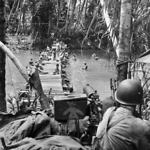
- Title
- USA Marines bathing in the Mataniko River, Honiara, 1940s, under armed guard
- Type
- Image
- Source
- Clive Moore
